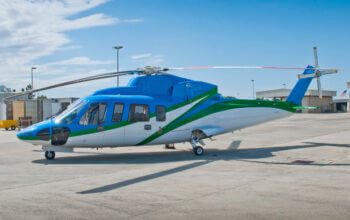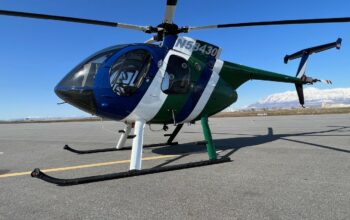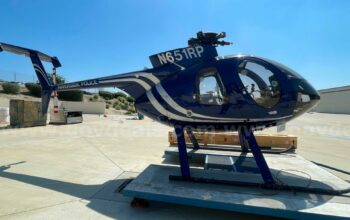The helicopter booking platform Blade is going public in a deal that will give it hundreds of millions of dollars for strategic acquisitions, strengthening its position as a leading provider of urban air mobility (UAM) services as it prepares for the arrival of electric air taxis.

The transaction, announced Dec. 15 and expected to close in the first half of 2021, will see Blade listed on the Nasdaq through a combination with Experience Investment Corp. (EIC), a special purpose acquisition company (SPAC) sponsored by an affiliate of KSL Capital Partners. SPACs are publicly traded shell companies created for the sole purpose of acquiring existing companies, and have recently surged in popularity, according to Goldman Sachs.
The combination with EIC will give Blade a valuation of $825 million and $400 million in gross proceeds, including EIC’s cash held in trust and an additional $125 million from new and existing investors. Blade and KSL have already identified around $300 million in short- to mid-term investment opportunities that will help Blade expand its presence in the northeastern United States, on the West Coast in San Francisco and Los Angeles, and in new markets that could include Vancouver, Jakarta, and Tokyo.
Founded in 2014 by former Sony and Warner Music executive Rob Wiesenthal, Blade launched as a way to book helicopter flights between Manhattan and the Hamptons. By allowing passengers to book single seats using a convenient app — versus the traditional, time-consuming process of chartering an entire helicopter — Blade tapped into a new market of first-time fliers.
Since then, the company has added new routes and an airport shuttle service in its core market of New York City; jet service between New York, Miami, and Aspen; and helicopter charters in the Los Angeles area. Blade has also expanded into India and created a new division, Blade MediMobility, dedicated to organ transports.
Blade does not operate aircraft itself, instead partnering with third-party operators to arrange flights for its passengers — nearly 40,000 of them last year. As Blade chief financial officer Will Heyburn explained in a Dec. 15 investor call, this asset-light business model means that the company’s costs are “100 percent variable on a per flight basis: If we don’t fly, we don’t pay.” In exchange for bearing the fixed costs of aircraft operations, Blade’s partners gain increased flight volumes without having to invest their own resources in marketing, customer service, or booking technology.
Although helicopters will remain central to Blade’s business for at least the next five years, the company has enthusiastically embraced the growing UAM movement, rebranding as “Blade Urban Air Mobility” last year. Like other players in the space, Blade is counting on quiet, cost-effective electric vertical take-off and landing (eVTOL) aircraft to dramatically increase the potential market for its urban shuttle service, and projects that it will begin to transition existing routes to eVTOL aircraft starting in 2025.
“Blade was specifically designed to be scalable and profitable using conventional helicopters today while positioned to smoothly transition to eVTOL tomorrow as soon as those aircraft are available, passing on lower operating costs to our fliers and enabling a reduced noise footprint and zero carbon emissions for the communities we serve,” CEO Rob Wiesenthal said in the Dec. 15 call.
“Early eVTOL designs are likely to have range and payload limitations, but will still be effective for our growing organ transport business, later our 10- to 15-mile airport transfer products, and then soon after our longer-distance businesses,” he added.
Blade’s announcement comes on the heels of Uber’s transfer of its own UAM division, Uber Elevate, to leading eVTOL developer Joby Aviation, which is aiming to certify and launch operations of its S4 air taxi by 2023. As part of that deal, Uber and Joby agreed to integrate their respective services into each other’s apps. A Joby spokesperson confirmed to Vertical that the app-sharing agreement is not exclusive in either direction, and that “Joby retains the flexibility to partner with other demand-generation partners in both U.S. and overseas markets.”
Meanwhile, Uber’s decision to divest Elevate has given Blade the opportunity to consolidate its gains in New York and the Northeast Corridor. Uber launched its own helicopter shuttle service, Uber Copter, in New York City last summer with the explicit goal of building the operational and technical foundations for its planned eVTOL service, Uber Air. However, Uber Copter was suspended due to Covid-19, and the transfer of key personnel to Joby casts doubt on any near-term resumption of the service.
In a slide deck for investors, Blade acknowledged that Covid-19 has had a significant negative impact on business lines including its airport shuttle service, but has also created opportunities. Notably, now is an “ideal time to pursue accretive mergers and acquisitions in the fragmented UAM ecosystem given current Covid-19 overhang and legacy aviation valuation metrics,” the company said.
Blade predicts its revenue to more than double once eVTOLs are introduced in 2025, as reduced costs allow the company to provide services to a greater percentage of the market. Blade expects eVTOLs will be able to service some of the longer routes in its network, such as NYC to Boston — 187 miles — and NYC to Washington, D.C. — just over 200 miles — by 2026.









